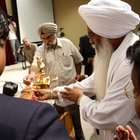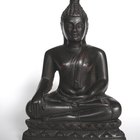
Hemera Technologies/AbleStock.com/Getty Images
The meaning of death and the funeral rites following death differ greatly between Christianity, the world's largest religion according to the BBC, and Hinduism, the third-largest religion in the world. For Christians, earthly life is viewed as temporary; it lays the foundation for the afterlife, in which the soul is judged and goes either to hell or heaven. Hindus, however, believe that after death, the soul is returned back into the cycle of reincarnation. The physical form in which the soul is reincarnated is determined by the deeds and actions of the person's previous life, and until the soul becomes perfect, this cycle continues.
Christianity and Death
According to the Bible, upon death a person's soul is judged by God and, depending on one's beliefs and deeds, will go either to heaven or hell. Catholics also believe in purgatory--meaning "to purge" or "clean" in Latin--which is a temporary limbo for those who have committed forgivable but unrepented "venial" sins and are not yet deserving to go to heaven. Death is also an important symbol in Christianity, as it is believed that the original sin that one is born with was atoned for with the death of Jesus Christ. In this sense, Jesus' death made it possible for a final reconciliation to be made between mankind and God.
Christian Funeral
After one's passing, the body is washed and embalmed for burial, or prepared for cremation. The funeral takes place about a week after the death. At funeral ceremonies and Masses it is appropriate to be dressed in black out of respect for the dead. Despite the diverse range of denominations, most Protestant funerals tend to be similar. A funeral service usually opens with the minister reading a passage from the Bible. The opening prayer is followed by a sermon; a reading that describes the life of the deceased; prayers and a silent time for reflection; a prayer of farewell; and the lowering of the coffin. Catholic services differ slightly from Protestant funerals. A vigil service takes place before the funeral Mass at a church or funeral home. This service includes an introductory rite, prayers and a blessing. The funeral Mass takes place the day after the vigil and includes Scripture readings and the Eucharist. At the end of the funeral, the coffin is taken out of the church to the cemetery, where the final committal service takes place.
Hinduism and Death
In Hinduism, final prayers are chanted at the moment of a loved one's passing. Prayers take the form of a mantra, and as it is being chanted, ash is placed on the dying person's forehead and blessed water or milk is dripped into the person's mouth. Following Hindu tradition, the body cannot be embalmed, nor are organ donations allowed. Traditionally, the deceased's body is cremated and only men may be present at the cremation ceremony. Before being placed on the pyre or into the fire chamber in order to be cremated, the deceased is carried counterclockwise around the fire.
Hindu Funerals
For a Hindu funeral, cremation takes place within 24 hours after death. The deceased's body stays at home until this time. During the time that the body is at home, a funeral service takes place. Unlike Christian funerals, loved ones at Hindu funerals should not dress in black, which is inappropriate; rather, dressing in white is preferable. Funerals are always "open casket," as guests are expected to pay their respects by viewing the body. A Hindu priest and a senior family member conduct and lead the ceremonies. The mourning period lasts anywhere between 10 to 30 days after the death.
Related Articles

What Happens at Hindu Funeral Services ...

Greek Orthodox Funeral Traditions

Catholic Church Funeral Rules for ...

The Common Procedures of a Catholic ...

Can a Catholic Mass Be Held at the ...

Jewish Funeral Etiquette for Gentiles

Do Muslims Wear White at a Funeral?

The Purpose of Christening

The Meaning of a Single White Rose

Why Do Brides Wear Veils?

Clergy Shirt Colors

How to Dress for a Bris Ceremony

What Happens to Dead People at a ...

What Religions Do Not Allow You to Have ...

Coptic Orthodox Dress Etiquette

How to Use a Veil & Cord in a Wedding

Contemporary Tenebrae Service Ideas

What Is the Meaning of Wedding Doves?

Prayer Shawls at Jewish Weddings

Etiquette for a Buddhist Wedding
References
- BBC: Christianity
- BBC: Hinduism - An Introduction
- BBC: Christian Death and Burial
- Funeralwise: Hindu Funeral Customs
- Funeralwise: Hindu Beliefs on Dying and Death
- BBC: Christianity - Beliefs About Life After Death
- New Advent Catholic Encyclopedia: Purgatory
- BBC: Atonement and Reconciliation
- Catholic Cemeteries: Ministry - The Vigil Service
Writer Bio
Jason Cristiano Ramon holds a doctorate in political science and a master's degree in philosophy. He has taught political science in China.
Photo Credits
Hemera Technologies/AbleStock.com/Getty Images